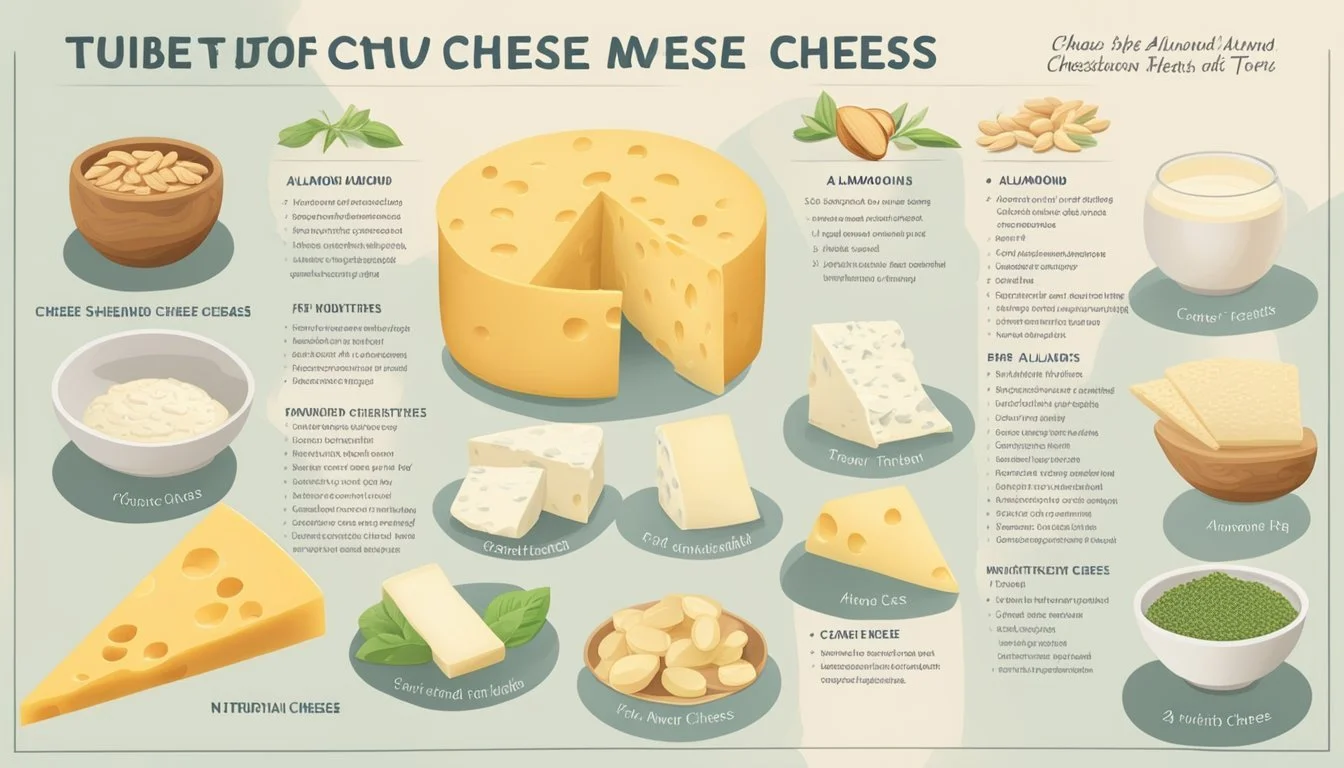Limburger Cheese Substitutes
Top Alternatives for Recipes
Limburger cheese, renowned for its potent aroma and creamy texture, has roots in Belgium, Germany, and the Netherlands. For many, its distinctive flavor is an acquired taste, often tricky to find or too strong to handle. Luckily, several substitutes can replicate either the texture or flavor of Limburger without overwhelming the senses.
For a creamy and soft texture akin to Limburger, Brie and Fontina are excellent choices. Brie offers a mild scent and a luxurious creaminess, while Fontina, a semi-soft cheese, closely mimics Limburger's texture. Brick cheese also serves as a fantastic alternative when more traditional European options like Munster or Liederkranz are unavailable.
When it comes to flavor substitutes, cheeses such as Camembert and Taleggio come to mind, each providing unique taste profiles while maintaining some of the boldness seen in Limburger. Raclette, Gorgonzola, and Blue Cheese are also viable options to consider for those seeking a robust cheese experience. These alternatives ensure that even without Limburger, dishes can still achieve rich and satisfying results.
Understanding Limburger Cheese
Limburger cheese stands out due to its pungent aroma and creamy texture. Its unique qualities and rich history make it a fascinating topic for cheese enthusiasts.
Origin and History
Limburger cheese originated from the historical Duchy of Limburg, an area now part of modern-day Belgium, Germany, and the Netherlands. It was first produced by Belgian Trappist monks during the 19th century. The monks perfected the technique of making this cheese, which later spread throughout Europe.
In the late 1800s, Limburger cheese was introduced to the United States by German immigrants. It quickly became popular among European immigrant communities and continues to be appreciated by those with a taste for strong, bold flavors.
Flavor and Aroma Profile
Limburger cheese is renowned for its strong, pungent aroma, which can be quite surprising for those encountering it for the first time. This distinctive smell is attributed to Brevibacterium linens, bacteria that colonize the rind as the cheese ages.
The flavor profile of Limburger is equally robust. It has a bold, earthy, and nutty taste that intensifies with aging. When fully ripe, the cheese exhibits a complex mix of creamy and slightly tangy notes.
Texture and Consistency
Limburger cheese is semi-soft and has a spreadable consistency. This makes it ideal for spreading on bread and crackers. The rind is often reddish-brown, a result of the bacteria and mold growth during the aging process, adding a slightly gritty texture.
The interior of the cheese is creamy and smooth, providing a pleasant contrast to the more textured rind. As it ripens, the cheese becomes softer and the creamy interior develops richer flavors.
Aging Process
The aging of Limburger cheese involves careful control of conditions to promote the growth of Brevibacterium linens. The process typically takes six to twelve weeks, during which the cheese is regularly washed with a brine solution.
This washing is essential to maintain the moist, salty conditions necessary for the bacteria to thrive. The result is a washed-rind cheese with a strong aroma and a flavorful, creamy interior. The aging process not only develops the cheese's distinctive flavor but also the characteristic pungency and texture.
Culinary Uses of Limburger Cheese
Limburger cheese, known for its strong aroma and unique taste, is versatile in culinary applications. It's ideal for traditional dishes and pairs well with various foods and beverages, enhancing flavors in creative ways.
Traditional Dishes with Limburger
Limburger cheese often complements hearty, rustic dishes. Rye bread with mustard and Limburger is a classic combination, where the strong cheese aroma meets the tangy kick of mustard, creating a robust flavor profile.
Another popular use is in grilled cheese sandwiches. Limburger's ability to melt smoothly makes it a great option. Paired with onions and mustard, it provides a rich, savory taste that stands out. Burgers can also benefit from a slice of Limburger, adding a tangy twist.
Limburger is not just for sandwiches. It can be used in potato dishes or melted over vegetables. Its full flavor pairs well with meals like casseroles, giving a unique twist to everyday ingredients.
Cheese Pairing
Pairing Limburger cheese with complementary foods and drinks is essential to balance its robust flavor. Hearty breads, such as rye, provide an excellent base for the cheese. Adding sliced onions or garlic further enhances the palate.
Fruits like apples or pears work well, adding a fresh, sweet contrast to Limburger's pungency. Nuts such as walnuts or almonds can also complement the cheese in a mixed platter.
When it comes to drinks, wine is a popular choice. A robust red or sweet white wine balances the strong flavor of Limburger. Additionally, beer pairings, particularly darker brews or Belgian ales, can complement the cheese's distinctive taste perfectly.
Limburger also pairs well with other savory foods like pickles, radishes, or even specific sausages, making it a dynamic and versatile component in diverse culinary settings.
Choosing Substitute Cheeses
Selecting the right substitute for Limburger cheese depends on factors like flavor profile, texture, and intended use. While some cheeses offer a close match in smell and taste, others provide a milder alternative for those who prefer less pungent options.
Factors to Consider
When choosing a substitute, consider the flavor profile, which is essential for maintaining the dish's desired taste. Limburger cheese is known for its pungent smell and creamy texture, so look for cheeses with similar qualities.
Texture also plays a crucial role, as Limburger's softness contributes to its spreadability. Finally, the cheese's use in recipes will guide whether a stronger or milder substitute is appropriate.
Closest Match Substitutes
For a substitute with a similar pungent aroma and strong flavor, consider Taleggio cheese. This Italian cheese mimics Limburger's creamy texture and strong smell, making it suitable for direct replacements.
Fontina, another strong-flavored option, offers a tangy taste and versatile uses in various dishes. Munster cheese, especially from the United States, shares similarities in smell and flavor, providing a quality alternative. Wisconsin Limburger is another excellent choice, maintaining close resemblance in taste and texture.
Milder Flavored Substitutes
Cheeses like Brie and Camembert provide a mild flavor with a soft and creamy texture. These substitutes cater to those who find Limburger too overpowering.
Havarti is another milder option, offering a smooth texture without the intense aroma. Gorgonzola Dolce, with its creamy consistency and less pronounced smell, can also serve as a suitable substitute.
Each of these alternatives allows for variety in flavor and application, making them adaptable to different culinary needs. Bel Paese and Robiola present additional mild options that still maintain a rich taste without overwhelming the senses.
Nutritional Value and Health Considerations
Limburger cheese offers significant nutritional benefits but should be consumed with caution due to its fat and sodium content. Key nutrients include protein, calcium, and other minerals, while dietary considerations focus on its impacts on health.
Fat and Protein Content
Limburger cheese provides a rich source of protein and fat. Each 100 grams of Limburger contains about 20 grams of protein and approximately 28 grams of fat. The high protein content, which is derived from cow's milk, is essential for muscle repair and immune function.
Nutrient Value (per 100g):
Protein: 20 grams (equivalent to 40% of the recommended daily intake)
Fat: 28 grams
Saturated Fat: Significant amount contributing to the daily limit
The fat content is predominantly saturated, which should be monitored to avoid excessive intake. Consuming saturated fats in high amounts can increase cholesterol levels, affecting cardiovascular health.
Dietary Considerations
Limburger cheese is high in calcium and phosphorus, beneficial for bone health. Each 100 grams serving provides a valuable amount of these essential minerals, supporting bone density and dental health.
Individuals with lactose intolerance should avoid this cheese due to its lactose content. Additionally, the high sodium levels can pose a risk for those with hypertension.
Key Considerations:
Calories: High-calorie content may contribute to weight gain if consumed excessively.
Minerals:
Calcium: Strengthens bones
Phosphorus: Essential for energy storage and utilization
Iron: Present in trace amounts
Balancing Limburger cheese with low-sodium and low-fat foods can help mitigate health risks while still allowing enjoyment of its unique flavor.
Proper Storage Techniques
Properly storing Limburger cheese is essential to maintaining its quality and extending its shelf life. Ensuring the right conditions and using the appropriate storage methods will help keep its unique characteristics intact.
Storage Conditions
Limburger cheese, a washed-rind cheese, thrives under specific storage conditions. It should be kept in the refrigerator at a temperature between 35°F and 42°F. This temperature range helps preserve the cheese's consistency and prevent rapid growth of unwanted molds.
A key factor is choosing the right container. A resealable plastic bag is convenient but not ideal. Opt for a cheese paper or wax paper. These materials allow the cheese to breathe while protecting it from excess moisture.
The fridge's vegetable crisper is an excellent spot due to its stable, cold environment. Limburger’s strong smell can permeate other foods, so consider storing it in a dedicated cheese container with a tight seal to contain aromas.
Extending Shelf Life
To extend the shelf life of Limburger cheese, periodic checks for mold are necessary. While surface molds can be a natural part of the aging process, any excessive mold should be trimmed off using a clean knife.
When cutting into the cheese, always use clean utensils. This reduces the risk of introducing contaminants into the cheese that can accelerate spoilage.
Keep the cheese wrapped properly. Once opened, re-wrap it in fresh cheese paper or wax paper, and store it in a resealable container. This combination preserves the cheese’s integrity and flavor.
Avoid exposing the cheese to room temperature for extended periods. When serving, only take out what you plan to consume and return the rest to the refrigerator promptly. This minimizes exposure to air and warmth, which can degrade the cheese’s quality.
Beyond the Cheese Board
Limburger cheese substitutes are versatile and can be incorporated into a variety of culinary applications beyond the traditional cheese board. From pasta dishes to themed cheese plates, discovering the versatility of these substitutes will enhance any culinary repertoire.
Alternative Culinary Applications
Limburger cheese alternatives can significantly elevate dishes like pasta, risotto, and even pizza. Taleggio and Fontina are excellent for adding creamy textures to macaroni and cheese or a rich cheese fondue. Their melting properties make them superb choices in gratin dishes as well.
In salads, softer cheeses like Brie and Robiola offer a delightfully creamy bite. For a unique twist on classic recipes, consider using Gorgonzola Dolce in a pear and walnut salad or Havarti in a summer vegetable risotto. The bold flavors of these cheeses can bring depth and complexity to a wide range of dishes, making them stand out beyond simple cheese pairings.
Creating Themed Cheese Plates
Crafting themed cheese plates using Limburger substitutes can provide an exciting experience for guests. Consider pairing Gruyere and Pont-l'Évêque with fresh fruits, nuts, and gourmet crackers. For an Italian-themed plate, combine Bel Paese and Fontina with Italian charcuterie, olives, and crusty bread.
Cheese plates themed around specific cuisines or flavor profiles can turn a simple gathering into a culinary adventure. Urgelia cheese pairs well with Spanish-inspired accompaniments like quince paste and Marcona almonds, while Brie can be matched with French baguettes and truffle honey for a touch of elegance. Always remember to balance the strong flavors with milder options to cater to diverse palates.
These thoughtful combinations not only showcase the cheese substitutes' unique qualities but also enhance the overall tasting experience by creating a harmonious blend of flavors and textures.







